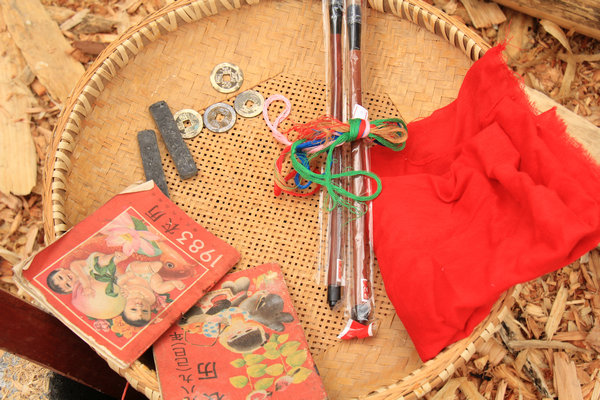 |
Traditional almanacs dating back 1,400 years are still used. [Photo provided to China Daily] |
Ancient China had the world's most-developed calendrical system, since agriculture was closely related with the seasons and launching new calendars for the coming year was an important symbol of a new emperor's rein, Zhang Peiyu, a scholar who studies the history of astronomy, writes in Chinese Ancient Calendars, published in 2008.
"An emperor's reign was accepted only when the subjects used his calendar," he writes.
"So, all the rulers for more than 3,500 years, starting with the Shang Dynasty (c. 16th century-11th century BC) and running through the Qing Dynasty (1644-1911), followed this idea. This made China the country with the world's most-advanced calendar system.
The ancient calendar systems were developed based on observations of celestial bodies' motions, seasonal changes in weather, and the life cycles of plants and animals, Wang Qizhong writes in the forward of the compiled book, Lectures on Chinese Ancient Astronomy and Calendrical Systems, based on lectures Zhang Wenyu delivered at Nanjing University in 1984.
"It can be traced back to 4,000 to 5,000 years ago, when written records appeared," Wang writes.
Since ancient Chinese believed celestial bodies' motions could tell the fortunes of people and countries, it was important for emperors to set up special bureaus and recruit "imperial astronomers" in charge of celestial observations.
They'd report to the emperors the most propitious days and times for the royal family to host weddings and funerals, and for the emperors to commence national worship ceremonies, as well as the taboos on specific days of certain solar terms.
This duty was also called "the art of choosing". It had become sophisticated by the Qin and Han dynasties (221 BC-220), Huang Yinong writes in Lectures on the History of Social Astronomy, published in 2004.
One example was Rishu ("the book of timing").
It served as a reference not only for people to choose the dates and the times for such events as wedding or journeys-many people died of disease or accidents while traveling in ancient times-but also for military leaders to attack enemies.
But understanding Rishu required special training, since they only provided basic information about the dates without further explanations. So, common people needed to consult experts.
In the Tang Dynasty (618-907), the first huangli, or royal calendar book, was printed by the government and sold to ordinary people, thanks to the development of woodblock printing, which dramatically reduced publication costs. These calendars offered more-detailed information about yi (good timing for) and ji (bad timing for) to guide common people's conduct. Royal calendar books' printing scale expanded quickly, starting with the Song Dynasty (960-1279). In 1328, during the Yuan Dynasty (1271-1368), as many as 3 million copies of calendars were sold. One-fourth of registered households owned one.
The royal calendar book was so popular in the Tang Dynasty that many private printers secretly sold copied ones. The Song government charged high prices to boost revenues and severely punished pirates.
The Yuan government encouraged people to report piracy and offered large rewards. Calendar books without official stamps would be counted as imitations. Such regulations lasted through the late Qing Dynasty.
However, official versions were too simple to satisfy people's complicated needs. So, in the Yuan Dynasty, there appeared different private versions, known as tongshu.
They were either detailed encyclopedic guides to people's lives or supplements to the official versions, to "help to interpret royal calendars".
However, different tongshu provided different interpretations on the same dates.
The divergences often led to confusion and even imprisonment of imperial astronomers in the Qing Dynasty. The confusion continued even though emperors in the Ming and Qing dynasties launched official reference handbooks.
Tongshu were so popular that they influenced royal calendars' sales. They were banned in 1723.
The unsuccessful ban was lifted in 1751, which turned a new page for the development of tongshu.
One of the most successful brands, Jichengtang-established by Hong Chaohe in Quanzhou, Fujian province, in 1798, according to Huang-is still popular. Jichengtang's tongshu are sold online.
At its peak, hundreds of thousands of copies of the brand's tongshu were sold, mainly to people in Fujian, Taiwan and Southeast Asia, Huang writes in the book. Huang examined the royal calendars made by imperial astronomers since the mid-Qing Dynasty. He found they also borrowed content and form from tongshu, which have been considered lowbrow and riddled with too much superstitious speculation.
"Tongshu profoundly reflect the close interactions between traditional Chinese astronomy and society," Huang writes.
After 1911, when the 2,000-year-old monarchy ended, people replaced the first character, huang (meaning royal), of huangli (royal calendar book) with another character (still pronounced huang, but meaning yellow) and continue using it to this date.

Presented by Chinadaily.com.cn Registration Number: 10023870-7
Copyright © Ministry of Culture, P.R.China. All rights reserved